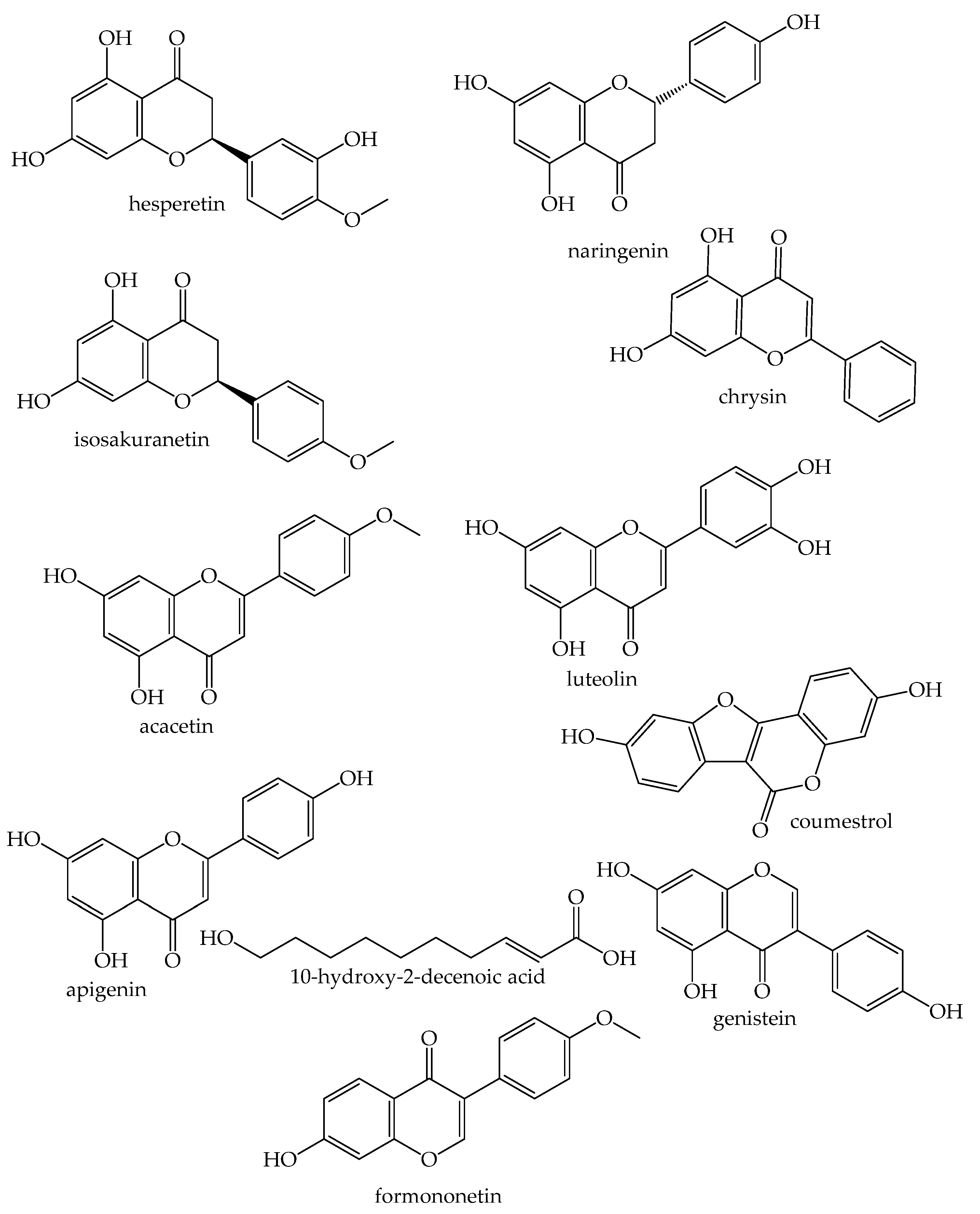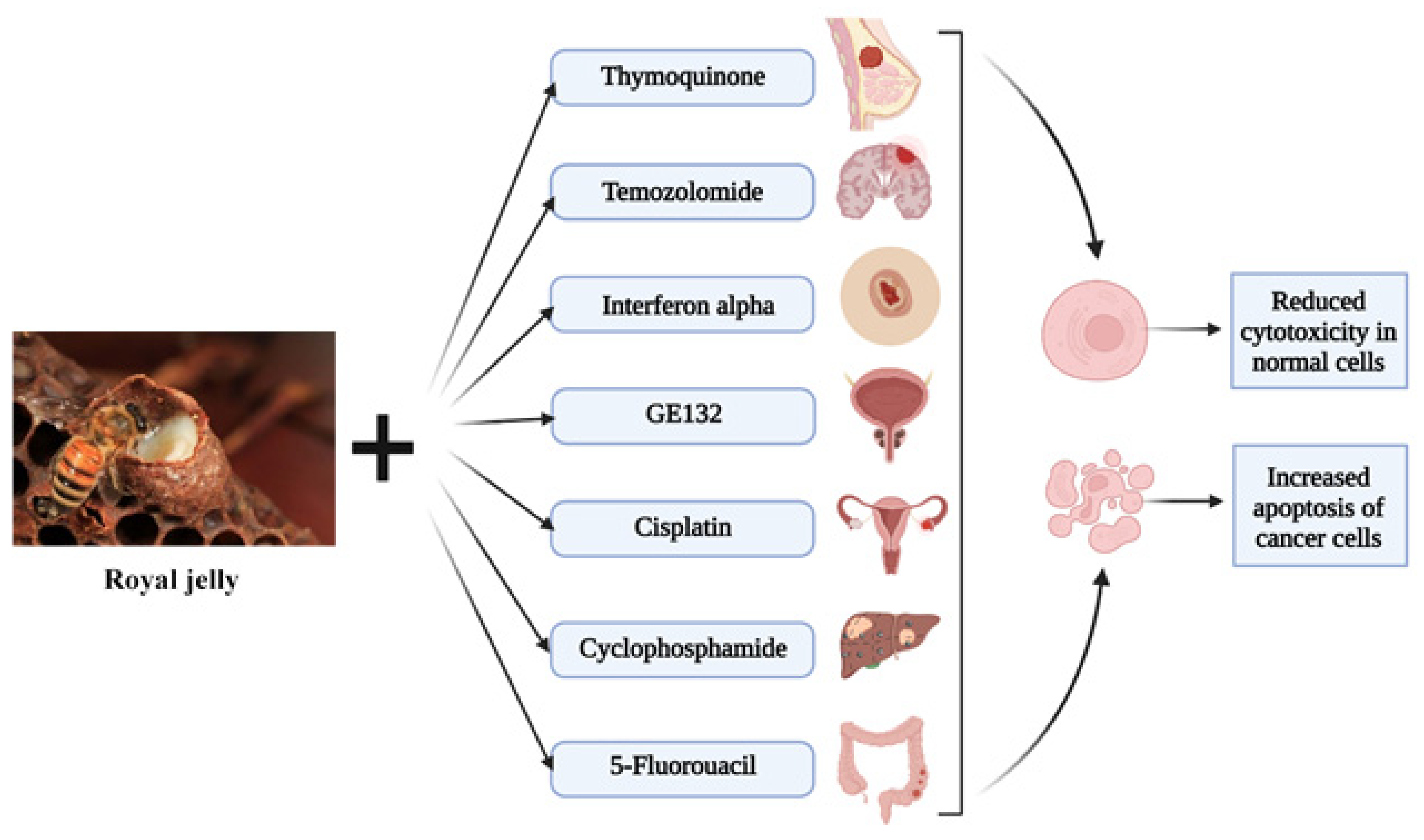
| Version | Summary | Created by | Modification | Content Size | Created at | Operation |
|---|---|---|---|---|---|---|
| 1 | Hesham El-Seedi | -- | 1449 | 2022-10-18 00:06:01 | | | |
| 2 | Lindsay Dong | Meta information modification | 1449 | 2022-10-18 04:13:44 | | |
Video Upload Options
Royal jelly (RJ) is produced by the hypopharyngeal and mandibular salivary glands of young nurse honeybees. RJ contains bioactive substances, such as carbohydrates, protein, lipids, peptides, mineral salts and polyphenols which contribute to the appreciated biological and pharmacological activities. Antioxidant, anticancer, anti-inflammatory, antidiabetic, and antibacterial impacts are among the well-recognized benefits. The combination of RJ or its constituents with anticancer drugs has synergistic effects on cancer disorders, enhancing the drug’s effectiveness or reducing its side effects.
1. Introduction
2. Anticancer Effects of Royal Jelly
It is well-known that some bee products have a positive impact on stopping cancer formation [8]. The antiproliferative activity of RJ was investigated, and RJ revealed potential anticancer properties owing to the inhibition of tumorigenesis, cancer cell proliferation and/or metastasis, via the inhibition of tumor-induced angiogenesis and/or the activation of immune function [9].
RJ exhibited a significant reduction in tumor mass and the serum concentrations of interleukin (IL)-4 and IL10, and cytokines released from type 2 T helper (Th2) cells, whereas the concentrations of IL-2 cytokines produced from type 1 T helper (Th1) cells, interferon (IFN)-α, superoxide dismutase (SOD), as well as total antioxidant machinery showed a significant elevation in an induced breast tumor. IFN-α level elevation manifested the role which RJ plays in immunomodulation. The enhanced release of antioxidant markers in the liver and kidney was another strong indicator of the antioxidant and immunomodulatory activities of RJ, with their possible association in the suppression of tumor growth in animal models [10].
However, it is also reported that RJ protein impedes the growth of human breast cancer cell lines induced by bisphenol A (BPA)—through the inhibition of the signaling pathway for cell proliferation induced by E2, and not as believed due to the inhibition of E2 attached to ER5. BPA is an estrogen-like substance used in commercial products such as polycarbonate plastics and synthetic resins, which are applied to coat the inside of beverage cans, and used to manufacture food wrapping paper and dental sealants. BPA has estrogenic activity and binds to estrogen receptors, stimulating the proliferation of human breast cancer MCF-7 cells [11] through the activation of the protein kinase/phosphoinositide3 kinase signaling pathway which is induced by estrogen receptor/human epidermal growth factor receptor 2 (HER2)/mitogen [12]. The crude RJ stops the damage of bisphenol A, which is a predisposition factor and hazardous insult that induces human breast cancer cell growth [11].

4. Interaction with Anticancer Drugs
Thymoquinone is a bioactive component of the Nigella sativa plant and has been proved effective in treating cancer, explained by its immunoenhancing and anti-oxidative properties [23]. Moubarak et al. demonstrated that the administration of RJ at a dose of 5 µg/mL combined with thymoquinone at the concentration 10 µmol/L for 24 h could reveal the remarkable induction of the caspase-3 apoptotic pathway and the death of human breast cancer cells MDA-MB-231. These findings were reproduced in different cell lines with similar effects and without any cytotoxic changes to normal human small intestinal cells [24].
Temozolomide is a conventional chemotherapy used against brain cancer, and approved by the Food and Drug Administration (FDA) in 2005 [25]. The addition of RJ extract (30 µg/mL) to temozolomide (20 µM) has synergistically elevated the cytotoxicity of the drug on the human glioma cell line U87MG [7].
Interferon alpha is a multi-subtype protein which is used as an antitumor drug. RJ and its active compound 10-HDAA were found to improve the potency of HulFN-αN3 when applied to the human colorectal adenocarcinoma cell line CaCo-2. The same report claimed the mechanism of action to be due to the augmentation of lipid peroxidation, the inhibition of cell proliferation and the depletion of glutathione (GSH) levels in colon cancer cells [26].
GE132 plus is a nutraceutical supplement which contains five strong antioxidant compounds, Ganoderma lucidum extract, RJ, resveratrol, sulphraphane and lycopene in one capsule (500 mg) [27]. In Traditional Chinese Medicine, it has been utilized for decades as a health-promoting factor for treating various diseases owing to its therapeutic properties, including the anticancer, immunopotentiator, and anti-hypertensive impacts [28]. Significant anti-proliferative effects through the potential inhibition of angiogenesis have been recognized upon administration of GE132 plus to breast cancer cell lines (MCF-7), prostate cancer cell line (PC3), and the human colorectal adenocarcinoma cell line (SW48). On the other hand, GE132 plus did not show significant cytotoxicity on mesenchymal stem cells or peripheral blood collected from healthy donors in vitro. The same report revealed that higher concentrations of GE132 plus (500–2000 µg/mL) exhibited a cytotoxic effect to normal human vascular endothelial cell line EA.hy 926.
Although modern chemotherapeutic drugs have shown an efficient improvement in patient survival, the adverse effects of these drugs represent a great concern for cancer patients as well as physicians. Cisplatin is a well-known drug that is used in many diseases [29] and an active drug in anticancer chemotherapy as well, yet its adverse hepatotoxic and nephrotoxic effects are the biggest challenges facing cancer patients [30]. Some in vivo and clinical studies have shown that the synergistic interaction of RJ with cisplatin, when both are applied simultaneously, has considerably attenuated the previously observed nephrotoxic and hepatotoxic effects.

References
- El-Saadony, M.T.; Zabermawi, N.M.; Zabermawi, N.M.; Burollus, M.A.; Shafi, M.E.; Alagawany, M.; Yehia, N.; Askar, A.M.; Alsafy, S.A.; Noreldin, A.E.; et al. Nutritional aspects and health benefits of bioactive plant compounds against infectious diseases: A review. Food Rev. Int. 2021, 1–23.
- Ahmad, S.; Campos, M.G.; Fratini, F.; Altaye, S.Z.; Li, J. New insights into the biological and pharmaceutical properties of royal jelly. Int. J. Mol. Sci. 2020, 21, 382.
- Zhang, X.; Yu, Y.; Sun, P.; Fan, Z.; Zhang, W.; Feng, C. Royal jelly peptides: Potential inhibitors of β-secretase in N2a/APP695swe cells. Sci. Rep. 2019, 9, 168–178.
- Collazo, N.; Carpena, M.; Nuñez-Estevez, B.; Otero, P.; Simal-Gandara, J.; Prieto, M.A. Health promoting properties of bee royal jelly: Food of the queens. Nutrients 2021, 13, 543.
- Al-Kahtani, S.; Taha, E.K.A. Effect of harvest time on royal jelly yield and chemical composition. J. Kansas Entomol. Soc. 2020, 93, 132–139.
- Li, S.; Tao, L.; Yu, X.; Zheng, H.; Wu, J.; Hu, F. Royal jelly proteins and their derived peptides: Preparation, properties, and biological activities. J. Agric. Food Chem. 2021, 69, 14415–14427.
- Borawska, M.H.; Markiewicz-Żukowska, R.; Naliwajko, S.K.; Moskwa, J.; Bartosiuk, E.; Socha, K.; Surażyński, A.; Kochanowicz, J.; Mariak, Z. Interaction of bee products with temozolomide in human diffuse astrocytoma, glioblastoma multiforme and astroglia cell lines. Nutr. Cancer 2014, 66, 1247–1256.
- Nainu, F.; Masyita, A.; Bahar, M.A.; Raihan, M.; Prova, S.R.; Mitra, S.; Bin Emran, T.; Simal-Gandara, J. Pharmaceutical prospects of bee products: Special focus on anticancer, antibacterial, antiviral, and antiparasitic properties. Antibiotics 2021, 10, 822.
- Kimura, Y. Antitumor and antimetastatic actions of various natural products. Stud. Nat. Prod. Chem. 2008, 34, 35–76.
- Zhang, S.; Shao, Q.; Geng, H.; Su, S. The effect of royal jelly on the growth of breast cancer in mice. Oncol. Lett. 2017, 14, 7615–7621.
- Nakaya, M.; Onda, H.; Sasaki, K.; Yukiyoshi, A.; Tachibana, H.; Yamada, K. Effect of royal jelly on bisphenol A-induced proliferation of human breast cancer cells. Biosci. Biotechnol. Biochem. 2007, 71, 253–255.
- Wu, C.H.; Chuang, H.Y.; Wang, C.L.; Hsu, C.Y.; Long, C.Y.; Hsieh, T.H.; Tsai, E.M. Estradiol induces cell proliferation in MCF-7 mammospheres through HER2/COX-2. Mol. Med. Rep. 2019, 19, 2341–2349.
- Miyata, Y.; Ohba, K.; Matsuo, T.; Mitsunari, K.; Sakai, H. A randomized, double-blinded clinical trial of royal jelly intake for anticancer effects and suppressing adverse events in renal cell carcinoma patients treated with tyrosine kinase inhibitors. J. Clin. Oncol. 2020, 38, 697.
- Sobral, F.; Sampaio, A.; Falcão, S.; João, M.; Queiroz, R.P.; Ricardo, C. Chemical characterization, antioxidant, anti-inflammatory and cytotoxic properties of bee venom collected in Northeast Portugal Filipa. Food Chem. Toxicol. 2016, 94, 172–177.
- Miyata, Y.; Sakai, H. Anti-cancer and protective effects of royal jelly for therapy-induced toxicities in malignancies. Int. J. Mol. Sci. 2018, 19, 3270.
- Lin, S.R.; Chang, C.H.; Hsu, C.F.; Tsai, M.J.; Cheng, H.; Leong, M.K.; Sung, P.J.; Chen, J.C.; Weng, C.F. Natural compounds as potential adjuvants to cancer therapy: Preclinical evidence. Br. J. Pharmacol. 2020, 177, 1409–1423.
- Karadeniz, A.; Simsek, N.; Karakus, E.; Yildirim, S.; Kara, A.; Can, I.; Kisa, F.; Emre, H.; Turkeli, M. Royal jelly modulates oxidative stress and apoptosis in liver and kidneys of rats treated with cisplatin. Oxid. Med. Cell. Longev. 2011, 2011, 981793.
- Tolnai, S.; Morgan, J.F. Studies on the in vitro antitumor activity of fatty acids. III. Saturated monocarboxylic acids. Can. J. Biochem. Physiol. 1961, 39, 713–719.
- Hattori, N.; Nomoto, H.; Fukumitsu, H.; Mishima, S.; Furukawa, S. Royal jelly and its unique fatty acid, 10-hydroxy-trans-2-decenoic acid, promote neurogenesis by neural stem/progenitor cells in vitro. Biomed. Res. 2007, 28, 261–266.
- Sugiyama, T.; Takahashi, K.; Tokoro, S.; Gotou, T.; Neri, P.; Mori, H. Inhibitory effect of 10-hydroxy-trans-2-decenoic acid on LPS-induced IL-6 production via reducing IκB-Χ expression. Innate Immun. 2012, 18, 429–437.
- Makino, J.; Ogasawara, R.; Kamiya, T.; Hara, H.; Mitsugi, Y.; Yamaguchi, E. Royal jelly constituents increase the expression of extracellular superoxide dismutase through histone acetylation in monocytic THP-1 cells. J. Nat. Prod. 2016, 79, 1137–1143.
- Dzopalic, T.; Vucevic, D.; Tomic, S.; Djokic, J.; Chinou, I.; Colic, M. 3,10-Dihydroxy-decanoic acid, isolated from royal jelly, stimulates Th1 polarising capability of human monocyte-derived dendritic cells. Food Chem. 2011, 126, 1211–1217.
- Almajali, B.; Al-Jamal, H.A.N.; Taib, W.R.W.; Ismail, I.; Johan, M.F.; Doolaanea, A.A.; Ibrahim, W.N. Thymoquinone, as a novel therapeutic candidate of cancers. Pharmaceuticals 2021, 14, 369.
- Moubarak, M.M.; Chanouha, N.; Abou Ibrahim, N.; Khalife, H.; Gali-Muhtasib, H. Thymoquinone anticancer activity is enhanced when combined with royal jelly in human breast cancer. World J. Clin. Oncol. 2021, 12, 342–354.
- Singh, N.; Miner, A.; Hennis, L.; Mittal, S. Mechanisms of temozolomide resistance in glioblastoma- A comprehensive review. Cancer Drug Resist. 2021, 4, 17–43.
- Filipič, B.; Gradišnik, L.; Rihar, K.; Šooš, E.; Pereyra, A.; Potokar, J. The influence of royal jelly and human interferon-alpha (HuIFN-αN3) on proliferation, glutathione level and lipid peroxidation in human colorectal adenocarcinoma cells in vitro/Vpliv matičnega mlečka in humanega interferona-alfa (HuIFN-αN3) na prolifera. Arch. Ind. Hyg. Toxicol. 2015, 66, 269–274.
- Okic-Djordjevic, I.; Trivanovic, D.; Krstic, J.; Jaukovic, A.; Mojsilovic, S.; Santibanez, J.F.; Terzic, M.; Vesovic, D.; Bugarski, D. GE132+Natural: Novel promising dietetic supplement with antiproliferative influence on prostate, colon, and breast cancer cells. J. BUON 2013, 18, 504–510.
- Baralić, I.; Stojmenović, T.; Anđelković, M.; Đorđević, B.; Dikić, N.; Radojević-škodrić, S.; Pejić, S. Effect of combined antioxidant treatment on oxidative stress, muscle damage and sport performance in female basketball players. Srp. Arh. Celok. Lek. 2019, 147, 729–735.
- Queirós, V.; Azeiteiro, U.M.; Soares, A.M.V.M.; Freitas, R. The antineoplastic drugs cyclophosphamide and cisplatin in the aquatic environment–Review. J. Hazard. Mater. 2021, 412, 125028–125038.
- Un, H.; Ugan, R.A.; Kose, D.; Bayir, Y.; Cadirci, E.; Selli, J.; Halici, Z. A novel effect of aprepitant: Protection for cisplatin-induced nephrotoxicity and hepatotoxicity. Eur. J. Pharmacol. 2020, 880, 173168–173176.




